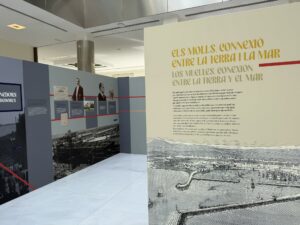
- The exhibition has been very well received, showcasing the history of Valencia’s maritime neighbourhoods
- Despite the bad weather during the first few days, residents and visitors came to discover this glimpse into the past of the “poblats de la mar” (seaside neighbourhoods) and the mark they have left on Valencia’s streets
- The exhibition has now closed its doors after several weeks in the Clock Building at the Port of Valencia
Valencia, 20th of November 2025 – The exhibition “El Marítim, a peu de carrer” (The Maritime District, at street level), promoted by Valenciaport in the iconic Clock Building, has concluded its exhibition with extraordinary acclaim. More than 7,500 visitors have taken part in this journey through the historical and cultural memory of Valencia’s maritime districts.
During its opening time, the exhibition received a constant flow of visitors, establishing itself as a highly regarded cultural event. Even in the early days, marked by episodes of bad weather, many people came to the Clock Building to enjoy this glimpse into the past of the ‘poblats de la mar’ (seaside neighbourhoods) and the mark they have left on Valencia’s streets.
A journey through Valencia’s maritime identity
The exhibition presented the history of the port community and the city through panels displaying texts and historical images, showing how fishing, trade, coastal defence and leisure influenced its transformation. Part of this history is still reflected in Valencia’s street names.
As in any city, the names of streets and squares preserve historical memory. In this case, the exhibition highlighted several of the place names in Valencia’s Maritime District, the result of the annexation of neighbourhoods such as Malva-rosa, Poble Nou de la Mar, Cap de França, Cabanyal, Canyamelar, Vilanova del Grau and Natzaret at the end of the 19th century.
Blasco Ibáñez and the anniversary of “Flor de Mayo”
The programme of activities running parallel to the exhibition was marked by the commemoration of the 130th anniversary of the novel “Flor de Mayo”, organised by the Casa Museu Blasco Ibáñez. To celebrate this anniversary, the Clock Building hosted a cultural day dedicated to the Valencian author.
The conference “Flor de Mayo: from serialised novel to film”, with Emili Sales (Head of the Blasco Ibáñez House Museum) and Carlos Aimeur (writer and teacher), analysed the journey of the work from its original publication in instalments to its film adaptations, as well as the lesser-known facet of Blasco Ibáñez as a pioneer in cinematic language.
A space for families as well The exhibition also stood out for its inclusive and participatory approach. In this regard, the exhibition featured a space for the whole family, decorated with furniture made from recycled fishing nets, where children could enjoy creative workshops, colour illustrations inspired by the exhibition and display their own drawings.

